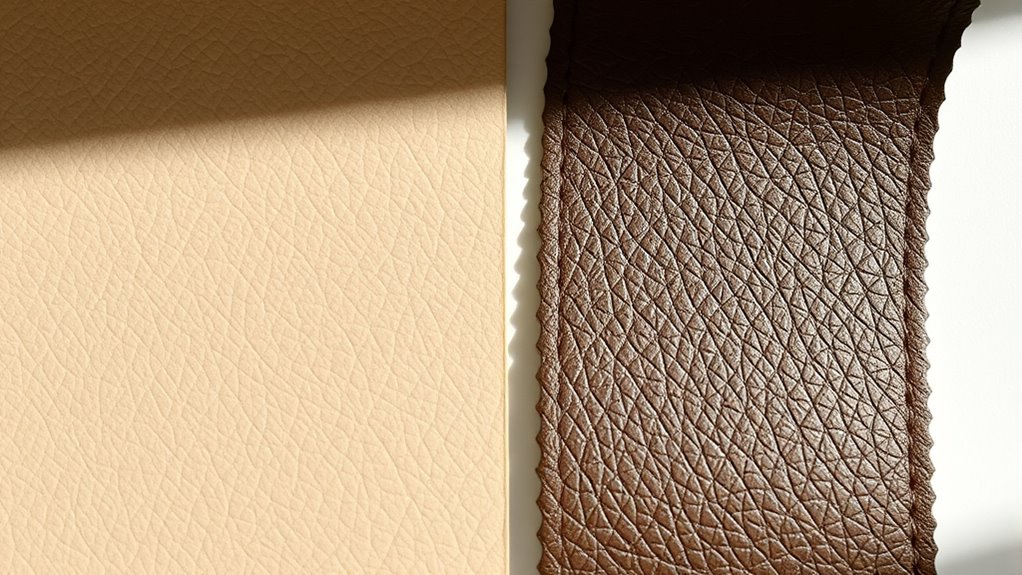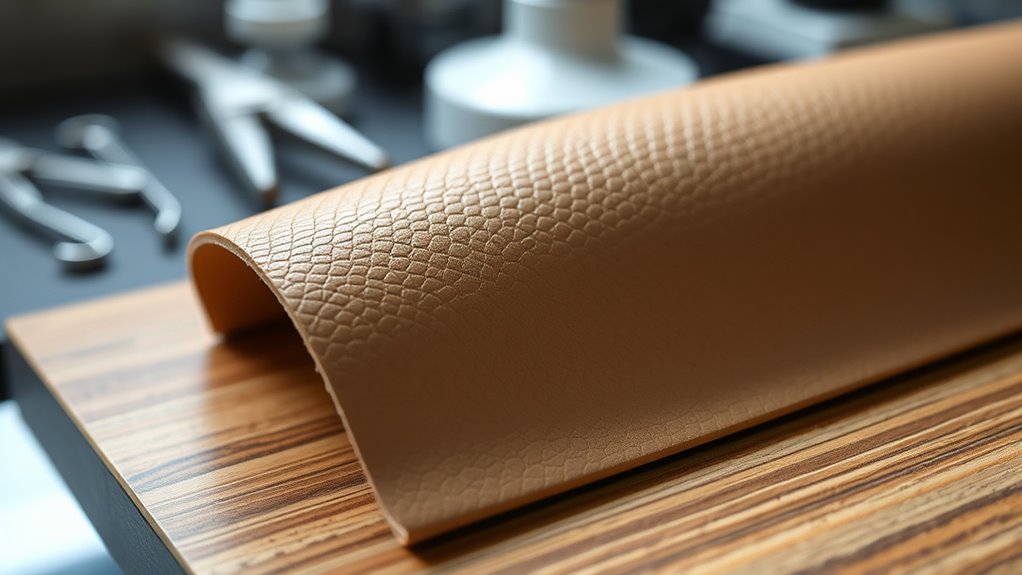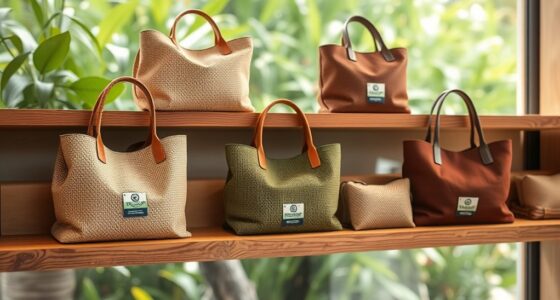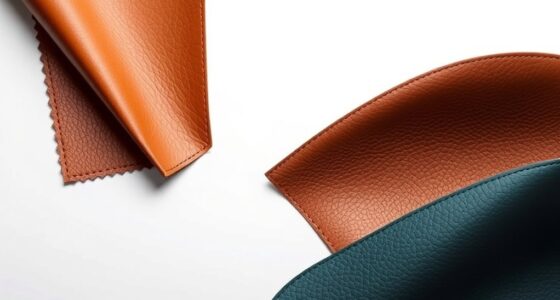Plant-based leather is a sustainable alternative that uses renewable plant fibers, requiring less water and chemicals than traditional leather. It generally has a smaller environmental footprint and produces fewer emissions. While some options offer decent durability, others might soften over time or need special treatments to last longer. Advances in materials are making plant-based leathers more resilient, but understanding their pros and cons can help you make an informed choice—there’s more to explore if you keep looking.
Key Takeaways
- Plant-based leathers offer environmental benefits, including lower water use, fewer chemicals, and reduced emissions compared to traditional leather.
- Durability varies; some products resist scratches and water, but may soften or degrade over time without treatments.
- Treatments and coatings can enhance lifespan and resistance to wear, stains, and moisture.
- Ongoing research aims to improve durability, making plant-based leathers more practical for everyday use.
- While eco-friendly, plant-based leathers may require careful maintenance and may have a shorter lifespan than traditional leather.

Is plant-based leather truly a sustainable alternative to traditional leather? This question often comes up as more brands and consumers seek eco-friendly options. When you examine the sustainability benefits of plant-based leather, you’ll find that it generally has a smaller environmental footprint. Unlike traditional leather, which involves raising livestock—an activity linked to high water use, greenhouse gas emissions, and land degradation—plant-based leather relies on renewable resources like cactus, mushroom mycelium, apple peels, or other plant fibers. These materials often require less water, fewer chemicals, and produce fewer emissions during manufacturing, making them a more eco-conscious choice.
Plant-based leather uses renewable resources, reducing water, chemicals, and emissions compared to traditional leather.
However, sustainability benefits aren’t the only factor to evaluate. Material durability plays a vital role in whether plant-based leather can genuinely replace traditional leather in everyday use. Some plant-based leathers have made significant strides in this area, offering decent resistance to wear and tear, scratches, and water, but others still fall short. You might find that certain options soften over time, especially if exposed to frequent moisture or rough handling, which can limit their lifespan compared to traditional leather. For instance, vegetable-tanned leather, which is often used in plant-based products, tends to be less durable than chrome-tanned leather, though it’s more environmentally friendly. Additionally, ongoing research and development efforts aim to improve the Material durability, which could make these options more competitive in the future.
It’s also important to recognize that durability varies depending on the specific material and manufacturing process. Some companies use innovative coatings or treatments to enhance the longevity of plant-based leather, making it more resistant to scratches, stains, and moisture. If you’re contemplating switching to plant-based leather, check how the material holds up under your typical usage. You may need to treat or care for it differently than traditional leather to extend its lifespan.
While plant-based leather offers promising sustainability benefits, especially in reducing environmental impact, its material durability can sometimes be inconsistent. That said, advances are ongoing, and newer formulations are emerging that aim to match or even surpass traditional leather in both durability and eco-friendliness. Your choice depends on balancing these factors: if you’re willing to accept some compromises on durability for the sake of sustainability, plant-based leather can be a worthwhile alternative. As research progresses, expect these materials to become more resilient, making them even more practical for everyday use.
Frequently Asked Questions
How Does Plant-Based Leather Compare in Durability to Traditional Leather?
You’ll find that plant-based leather generally isn’t as durable as traditional leather, especially when it comes to synthetic alternatives. While some plant-based options have improved in material longevity, they often wear out faster, especially with daily use. However, advancements are making these materials more resilient. If durability is your priority, traditional leather still outperforms plant-based options, but the gap is narrowing as technology progresses.
Are Plant-Based Leathers Environmentally Sustainable Long-Term?
Yes, plant-based leathers can be environmentally sustainable long-term if they come from eco-friendly farming practices and utilize renewable resources. You’ll find that sourcing materials responsibly reduces environmental impact, making these alternatives more sustainable. However, it’s important to take into account supply chain practices and land use, as not all plant-based leathers are equally eco-friendly. When produced thoughtfully, they can be a greener option that supports long-term environmental health.
What Are the Cost Differences Between Plant-Based and Genuine Leather?
You’ll find that plant-based leather generally costs less than genuine leather, making it more market affordable for many consumers. The cost comparison shows that plant-based options often use fewer raw materials and have simpler manufacturing processes, which helps keep prices down. While genuine leather can be pricier due to its durability and traditional production methods, plant-based leathers offer an attractive, budget-friendly alternative without sacrificing style.
How Resistant Is Plant-Based Leather to Water and Stains?
You might be surprised, but plant-based leather’s water resistance varies depending on its treatment. Generally, it offers moderate resistance, meaning it can handle light splashes but isn’t fully waterproof. When it comes to stain susceptibility, plant-based leather can be more prone to stains without proper sealing or maintenance. So, while it’s eco-friendly, you’ll need to treat it carefully to keep it looking its best against water and stains.
Can Plant-Based Leather Be Recycled or Biodegraded Easily?
Plant-based leather faces biodegradability challenges because its materials often need specific conditions to break down. Recycling processes can be complex, as they vary depending on the plant fibers and adhesives used. You might find it difficult to recycle plant-based leather through standard methods, and it may take longer to biodegrade compared to natural materials. Proper disposal and innovative recycling solutions are essential to improve its environmental impact.
Conclusion
Now that you’ve explored the pros and cons of plant-based leather, it’s clear this eco-friendly alternative offers both promise and challenges. Will you choose sustainability over traditional materials, knowing the environmental impact and durability concerns? As you weigh your options, remember that your choice can make a difference for the planet. Embracing plant-based leather might just be the step toward a more sustainable future—are you ready to make that change?









